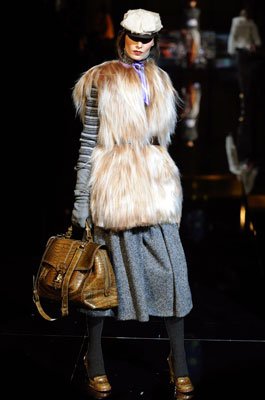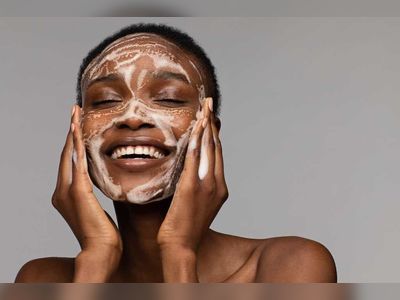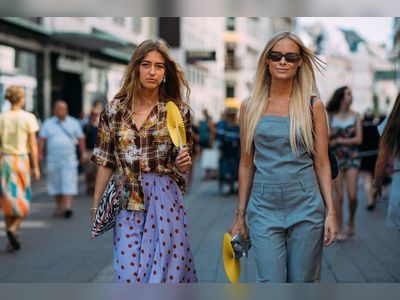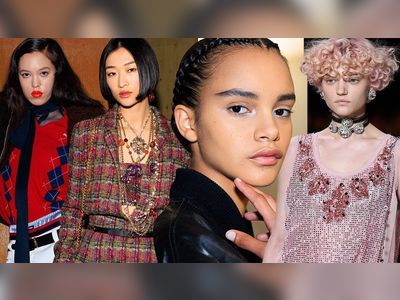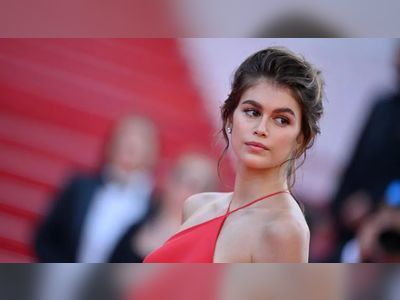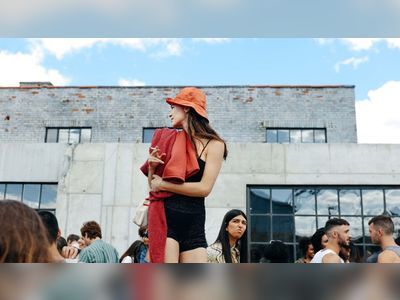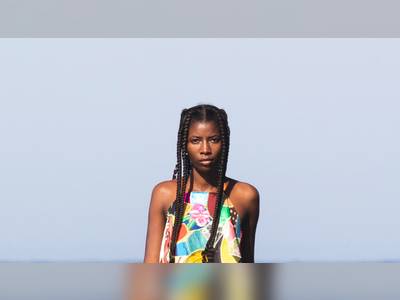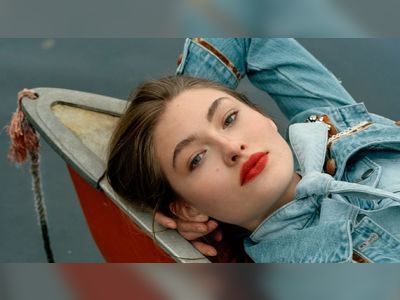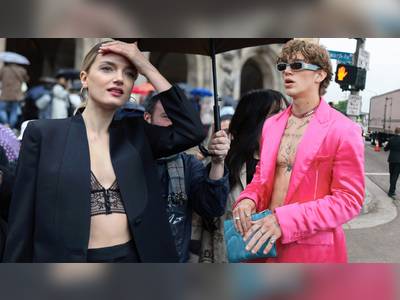MILAN: Whether it was the last leaves of autumn drifting over the shoulders at Fendi or the lambswool throw across a Dolce & Gabbana ball gown, there is a sense, as the Milan season draws to an end, of the softening up of luxurious, hard partying, extravagant fashion.
The mood is not exactly back to nature - although forest stage sets, woolly sweaters and thick hose are everywhere. But the hard, strident confidence that has powered fashion for a decade has taken a different path.
The turnaround at Dolce & Gabbana since the metallic, high-tech, super-sexy collection of a year ago, is so dramatic that the audience at the show Thursday gasped to see the designer duo go so long and so soft - even though the flower-strewn summer collection had presaged change.
What thoughts must have been going through the currently brunette head of Lindsay Lohan, 21, a Hollywood starlet born the year when David Bowie fell to earth and 10 years after his 1970s heyday, to see that era revisited? There it all was: hefty, hippie Mongolian lamb vests; midcalf tweed skirts; bunchy dresses with patterns of pelts; and that so unglam rock garment - the scallop patchwork brown leather jacket.
Who could envisage, on a certain balmy Hollywood night two days from now, walking the red carpet in a tulle gown with an apron of white shearling bulking out the dress - the ultimate in lamb dressed as mutton?
But a funny thing happened halfway through the show, as the heavier pieces gave way to colorful, fluttering scarf skirts and as knitwear clung to the curves: the silhouette that Domenico Dolce and Stefano Gabbana had reinvented looked fresh and quite charming. It was probably not a wise decision to show it so literally, with flat caps, thick knit stockings and chunky shoes (even if they were glitter gulch high-heeled lace-ups). As if we hadn't got the period mood from Bowie's "Fashion" soundtrack, Iggy Stardust in his 1970s glory appeared as a face on a T-shirt.
But take away all the references and Dolce & Gabbana is the first label to have the courage to go unequivocally for the calf-length skirt, for solid clothing and for a new, anti-party look. There was almost nothing of their slinky or trashy, nightclub clothes, although the male tailoring, which is their signature, had a walk-on role. Since fashion often reads the tea leaves better than the analysts, perhaps the party really is over and the "R" word (recession) has given to these two powerful designers a new edge.
Fendi's duo - Karl Lagerfeld and Silvia Venturini Fendi - both talked the same language.
"Real gold on fur - it has never been done before," said Lagerfeld, referring to a Fendi invention that made fox glow like a carpet of golden autumn leaves.
"And we want classic things," said Venturini Fendi, meaning not just the furs cinched with a wide belt but otherwise left to show the natural ripple of sable and fox, but also a new attitude to the iconic Fendi bags. Apart from evening clutches set with semiprecious stones, the bags were solid, sensible and - for the first time since Fendi baptized the "Baguette" a decade ago, they will have reference numbers rather than identifying names.
It would be good to say that Lagerfeld presented an equally firm statement with the clothes. But there seemed to be a slight hesitation between showing only the rounded short skirts with leather, fur and cable-knitted tops - or whether to extend the range. Leather skirts that hit the floor looked cool in proportion to the upper half but who is really going to wear such gothic floor sweepers?
The same applied to many of the leaf effects, although they were rather beautiful as cutouts on skirts or jackets, in tune with the bare trees projected as the backdrop. Where Lagerfeld scored was with the sweep of a cape-sleeved coat and the overall feeling that everything was perfectly in proportion, from the swelling sleeves to thigh-high boots.
The designer dismissed the idea that length can still be a fashion issue, saying: "You can't make hemlines a subject - it is not about the length, but the proportion."
The Emilio Pucci invitation, with its heritage photograph of a colorful figure on the mountain slopes, explosive pattern on the jacket and hefty skis from the 1960s, captured the outdoor freshness of the show Thursday.
Thick knits, worked in a patchwork of quiet shades or felted wool coats, their fuzzy surfaces toning down the vivid geometric patterns, made for a more varied collection. There were still a few too many little dresses in bright colors under chubby fur coats, worn by models whose laced boots were strictly for après ski.
Explaining that Emilio Pucci himself had wanted his jet-set prints to capture the speed and velocity of his era, the designer Matthew Williamson said backstage that he had created on the computer five new prints, from an alpine landscape with abstract fir trees to diamond patterns, in order to "break down the sometimes chaotic prints."
There is still a sense that Williamson is skating across the surface of Pucci, yet the show was lively and well-planned. The Alpine theme brought icicles of crystal on clutch bags or as jewelry, giving a sophisticated vibe to the sporty theme. Intriguingly, the most intense patterns in the show were on a few ultra-long dresses, while the overall silhouette was short and snappy. Williamson, as with most designers, is tinkering with change.
Brioni's show, created by a design team, was as it should be: luxurious, sophisticated and in rich colors like eggplant and burgundy among the black. The silhouette was long and lean, outlining but never gripping the body, often with a blouson effect to add volume to the upper half. Lush fur trims or a streamlined curly lamb coat added to the elegance. Although the legacy of the previous designer left a few flashes of bared flesh at the back, the show captured the sartorial style that Brioni has always produced for men, but which now has a female component.
Whatever has happened at DSquared2? The witty, energetic sportswear that was the brand's trademark seemed to have turned into a silly pastiche of couture. Most of the outfits ended up looking like a fast-fashion company had embarrassed itself by showing on the Milan runways. Although "running" was the last thing the models could do, as they balanced precariously on metallic pin heels and often resorted to taking off the torturous footwear.
With an occasional plaid clutch bag, dress or coat lining and some silver zippers, there was a faint echo of the posh punk from January's menswear show, since the designers Dean and Dan Caten kept the same London street set. But it just isn't good enough at the international collections to send out a bunch of clothes with no significant brand identity, without even producing the camp romp that used once to be DSquared2's signature.
Suzy Menkes is fashion editor at the International Herald Tribune.
